As July began our water levels continued low, but cloudy and potentially showery weather seemed to offer some hope of refreshing the tributaries. Accordingly we watched the towering cumulus clouds and waited hopefully for rain, while even the weather professionals seemed unable to predict exactly how much would fall and where. Meanwhile as high summer approached the rivers everywhere seemed busy with people on holiday. On 30th June AB from Hereford took 6 trout and 4 grayling on the upper Wye at Abernant, but reported that canoeists and swimmers, presumably house guests on the estate, were making life difficult for anglers. This has occurred on several occasions lately. The lower, navigable section of the Wye was of course filled with canoes as usual at this time of the year.
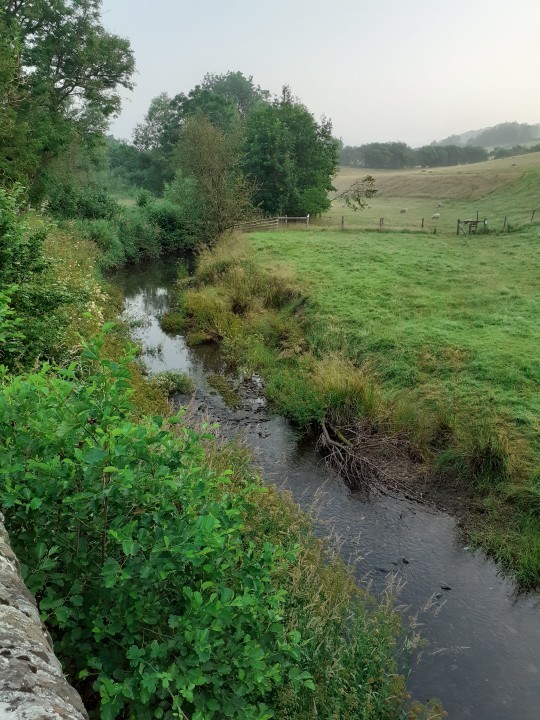 Edw at Hundred House - JA from Leominster
Edw at Hundred House - JA from Leominster AS from Collingham prospected likely places on the Arrow at Whittern and got 5 fish with a Monnow Gosling. I should clarify, by the way, that I don’t claim to have invented this one; it’s a slight modification of a mayfly pattern for the Irish lakes called there simply the Gosling! JA from Leominster was out on the Arrow at Kington next day and took 9 trout on various parachute dries. Again there were calls for more maintenance work. In the case of Kington I believe that an angling club is involved. SJ from Aberaeron booked both Dinas and Abercynrig and experienced a good day which ended in a superb evening rise; 16 trout to 2 pounds were taken on dry fly. ME from Aberdare had 10 trout on nymphs from the Beacons Reservoir on the 4th. A day later JA from Leominster was out again at Whittern and took 8 trout on a size 16 Parachute iron Blue.
CT from Cardiff came to the Honddu at Lower Stanton on the 6th and found that heavy showers had produced an effect at last, raising the level only slightly but turning the water a chocolate brown colour. Accordingly he fished with a black streamer and accounted for 20 trout to 14 inches. Incidentally, CT has a theory that hefty trout caught from the Honddu lately owe their bulk to dining on crayfish. It’s certainly food for thought. MH from Swansea was due to fish for salmon at The Rectory, but found the Wye rising and eventually unfishable due to colour. Nevertheless, he made good use of the trout rod instead and accounted for 7 together with 3 grayling. This rise was very short-lived and our rivers were soon back to low summer levels.
MH from Gilwern had a 36 inch cock salmon from the Usk at Dan y Parc on the 6th, which I dare say was very welcome. Two days later PD from Great Missenden took two salmon from The Rectory on the upper Wye, using an upstream Mepps in the Mill Stream. This is often a good bet in low water, as is the upper part of the Rectory before it runs into the deep water of the main pool. HJ from Bridgend fished the Honddu at Maes y Beran and got 8 trout from fast water on an Elk Hair Caddis. MH from Swansea fished at Gromaine for 7 trout and 7 grayling. Between the fences and the cattle, JE from Houghton-on-the-Hill struggled with access to the middle Usk’s Upper Tower beat, but caught a real specimen trout – see the photograph.
On the 10th MR from Liverpool was one of the busier coarse fishers, taking 47 chub from Fownhope No 5. MP from Swansea with a friend fished at the Usk Reservoir, where each of them took a limit bag of 6 trout on orange lures and later dry flies. KL from Bristol had a good day on the Bideford Brook, where he accounted for 11 trout from 8-10 inches. MD from Llanelli fished an evening on the Towy where he accounted for 5 brown trout plus a small sewin on an F-Fly. BP from Pembridge fished up at Llyn Bugeilyn where he took 18 trout during a cloudy morning. We haven’t had a report from the Lower Cammarch for a while, but JA from Leominster caught 11 trout there on the 12th.
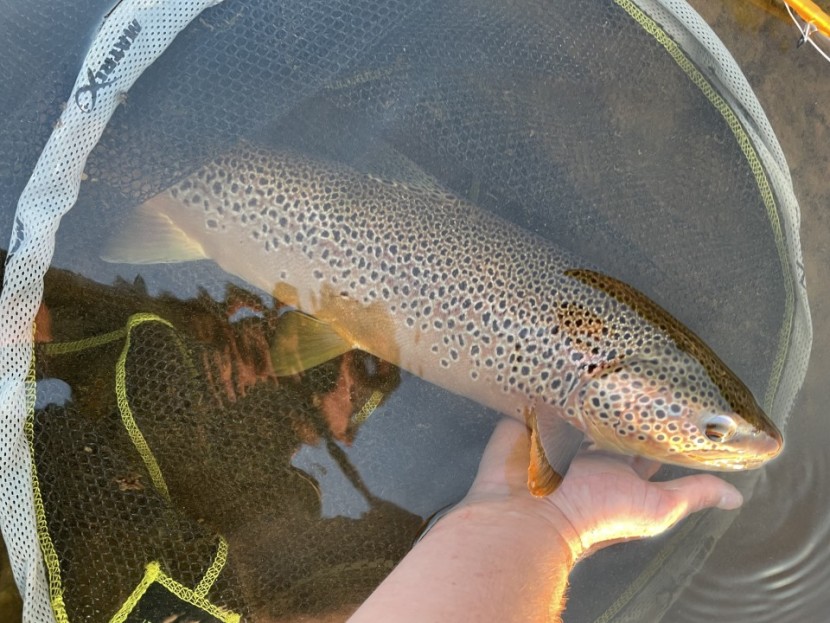 Middle Usk specimen - JE from Houghton on the Hill
Middle Usk specimen - JE from Houghton on the Hill 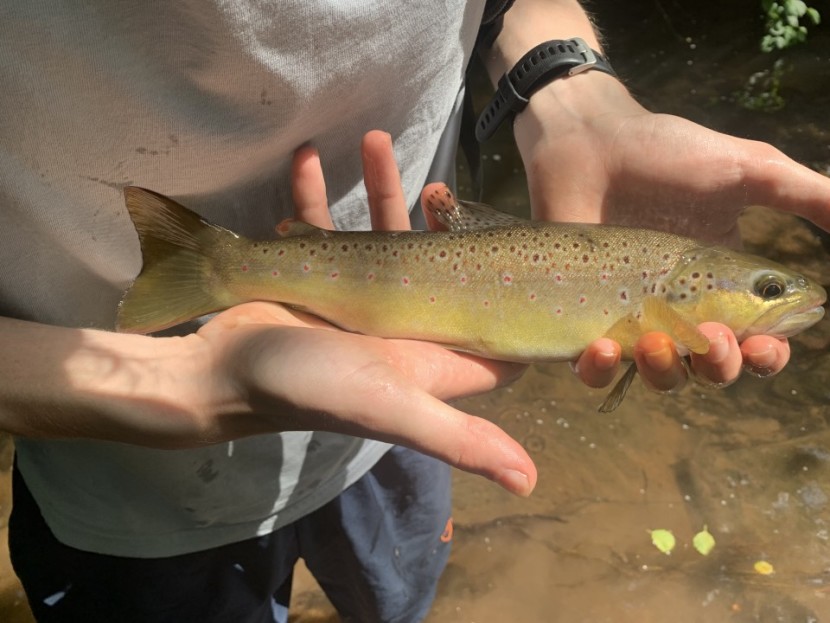 Longtown trout - TL from Kingsland
Longtown trout - TL from Kingsland About this time we did have a few heavy showers, but they were very much localised and apart from little rises of an inch or two and some colour here and there in the tributaries, the main rivers were not affected. I noticed DC from Mountain Ash lost a fish from the Chapel Catch of the Llangoed and Lower Llanstephan beat. I think I have talked to Dennis in the past and he loves that beat, while the Chapel gutter is certainly a likely low water catch. Bad luck! CT from Cardiff reported 17 trout on nymphs and streamers from the Lower Longtown beat of the upper Monnow. Mick Sutton had a slightly coloured salmon of 13 pounds from the top of the Vanstone run at Goodrich Court. That aside, all salmon caught during this period were from below Monmouth. Quite a few anglers were expressing disappointment with the tough fishing, but it should be remembered this was now mid-summer with hot temperatures at last and a bright sun.
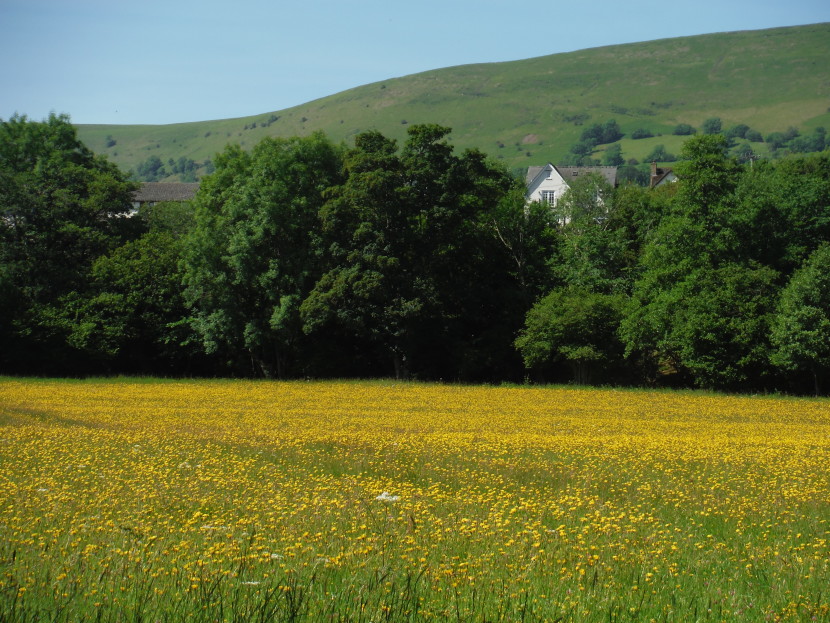 Longtown in the valley of the uper Monnow
Longtown in the valley of the uper Monnow 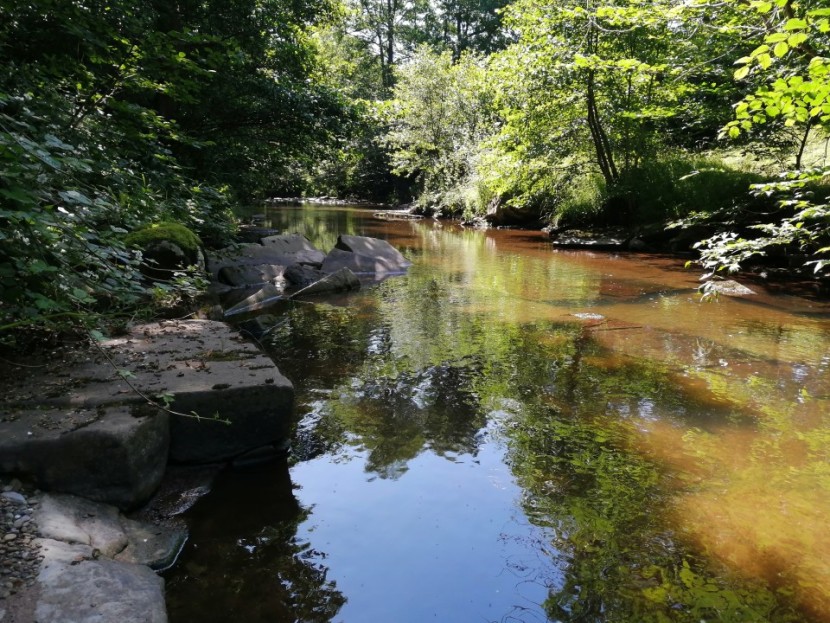 Lower Longtown - AP from Wirral
Lower Longtown - AP from Wirral 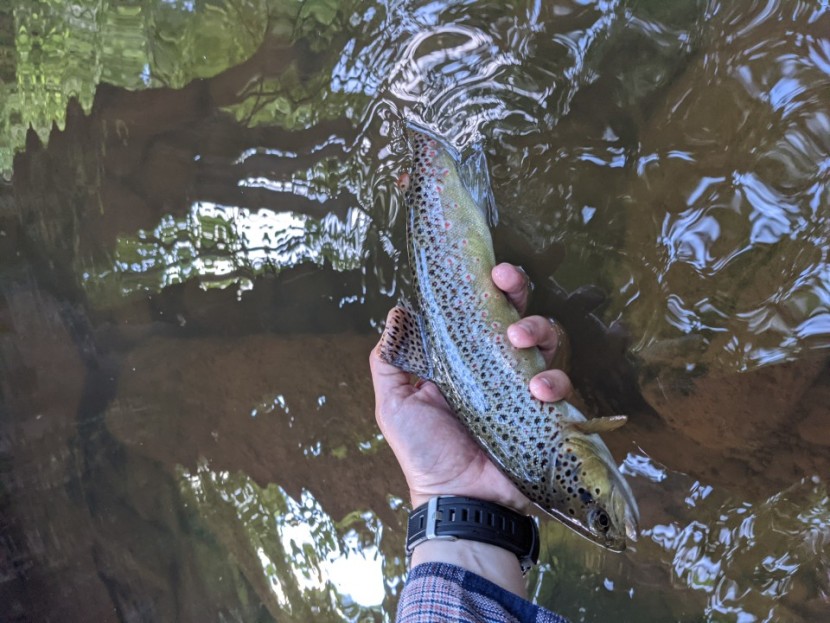 Lower Longtown trout - CT from Cardiff
Lower Longtown trout - CT from Cardiff AM from Worcester with a friend fished at Lyn Bugeilyn on the 14th, had a very good day with 40-odd trout caught, but had this to say in his report regarding the long (and improved) mountain road into the hills:
“WARNING - Print off the Map and Directions or write down the gate padlock code prior to visiting. On arrival the gate was closed with no padlock. When we left the padlock was on the gate. Fortunately I had the foresight to write down the padlock code (because) when I checked my emails I was unable to view the attachments with the code on due to no phone service in the area.”
I couldn’t make the point better than that. A night in the hills followed by many miles of walking and maybe phone calls to retrieve a trapped vehicle would not have been much fun. Make sure you have the information you need when you visit our fisheries and the best way to have it is printed off and in your pocket. Many of our fisheries are in remote areas without internet access. For that matter, smart phones and other devices can give you an unpleasant surprise by running their batteries down. And finally don’t rely on the satellite navigator; the other day an angler, rather than follow the directions with his ticket, entered the word “Abernant” on a satnav and was taken off to somewhere in Carmarthenshire, before he fortunately realised what was going wrong. There’s more than one Abernant in Wales!
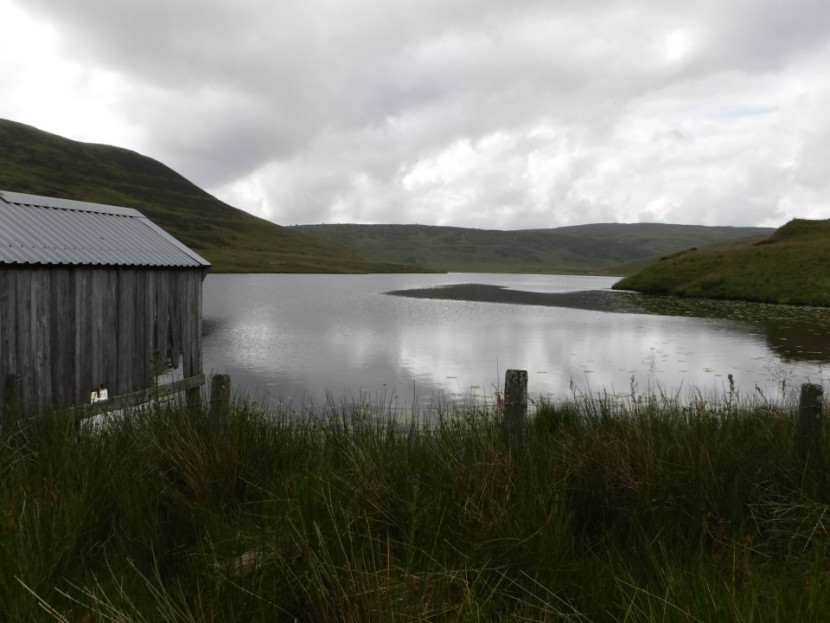 Llyn Bugeilyn - BP from Pembridge
Llyn Bugeilyn - BP from Pembridge 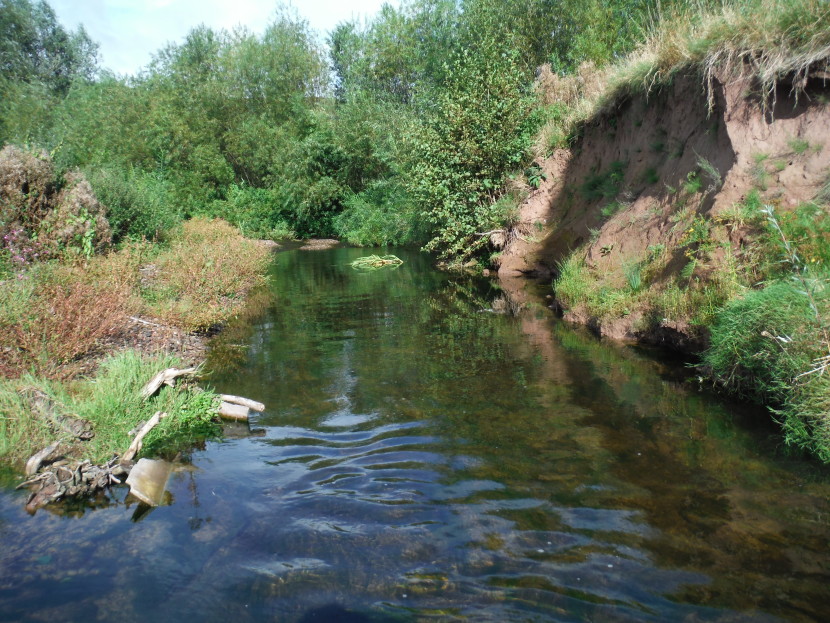 Upper Monnow down on its bones
Upper Monnow down on its bones By now the skies had cleared and a proper heat wave was developing, although there were dramatic floods nearby on the continent of Europe. DA from Newcastle under Lyme had a hard day at Lower Clochfaen and wrote: “I am slowly beginning to wonder if river fishing is worth the effort; it seems so poor compared to a few years ago. This seems to be true of most rivers.” Well, I think we can all feel a little like that after a difficult day, and I will be the first to admit that our rivers are under threat from several different causes – see paragraphs below. But at the same time, it isn’t really fair to compare a low river and bright sun on a July day to a warm cloudy day in April or maybe a mild day in October. Our memories about the “good old days” are, let’s face it, sometimes a bit selective and for certain anecdotal. One thing I can remember is that sun, water and weather have always had a decisive effect on the quality of fishing for trout and grayling. RB from Carmarthen fished with worm to take 6 trout from the Usk Reservoir: “…breezy, mixed cloud and sun…a beautiful place to be.” On the 15th AL from Treorchy caught 6 fish from Llwyn On: “…caught limit, good day’s fishing as well as the weather.”
On the 16th JT from Merthyr Tydfil also caught a limit of 6 trout from the Usk Reservoir. JA from Leominster visited the Upper Cilieni where he had an exciting morning catching 13 trout to 10 inches with a tiny parachute dry fly. AP from Wirral caught a couple of small trout from the shrunken Monnow at Lower Longtown and lost a few more. He wanted to know the purpose of the wooden gates across the river; they are intended to prevent drinking cattle making their way up the channel. The following day JT from Macclesfield had a nasty accident, falling and cutting his head on the Fenni Fach beat of the Usk, and necessitating a visit to Brecon hospital. Fortunately he was not there alone. Earlier he had caught 4 on a Deer Hair Emerger and noted that the lower part of the beat had been invaded by swimmers. Similarly on the 18th RW from Hereford with a friend caught 4 trout and 6 grayling from Doldowlod on the upper Wye, but found the beat invaded by trespassers in inflatable boats.
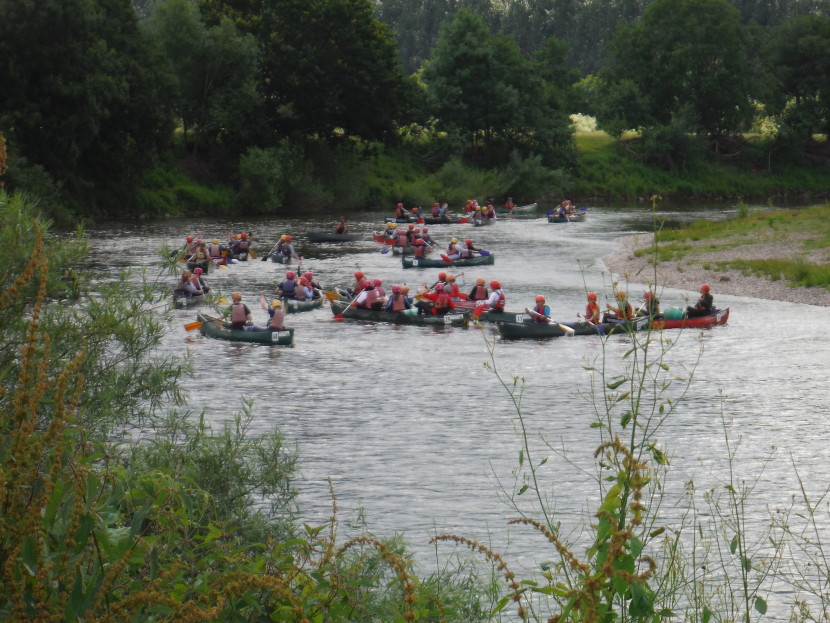 Lower Wye - a dense hatch of canoes
Lower Wye - a dense hatch of canoes 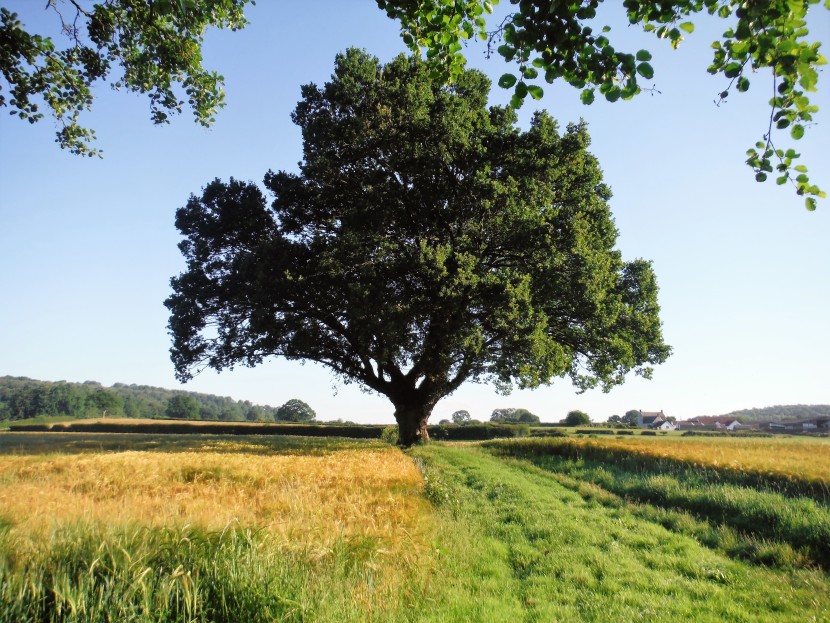 High summer
High summer At least warm days and low water do not usually discourage sea trout by night. The Towy, in particular, benefits from cold water from the bottom of the dam upstream. Our friend Myles, who is very experienced with sewin, described an interesting evening and on this occasion the Surface Lure, my favourite method, proved to be the star. After darkness fell, he went down the long pool with a tube fly as usual and touched nothing. After a little rest and presumably a restorative coffee, he went down the same pool with the Surface Lure, turned over 6 sewin, caught one, and finally lost a monster during play. That’s a night with Welsh sea trout for you!
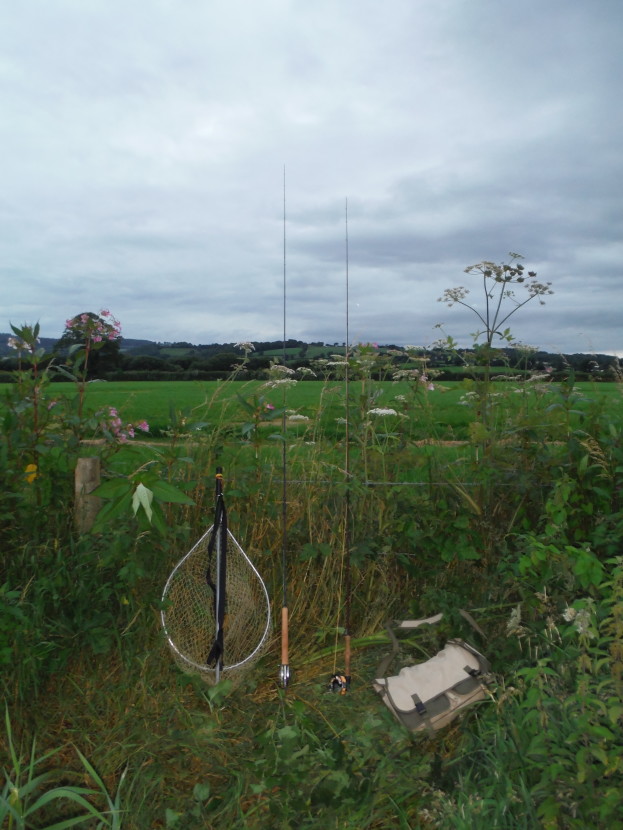 Cloudy sky and waiting for the sea trout night
Cloudy sky and waiting for the sea trout night The heat continued to increase and in fact extreme weather of one kind or another affected most of Europe. My brother-in-law and his wife travelled from Sweden to Mostar and nearly collapsed with heatstroke after tending a family grave in a temperature of 43 degrees. In Western Europe, the Rhineland and parts of Belgium and the Netherlands were affected by sudden and lethal flooding. In the UK, a weather emergency was declared. On the 16th the Foundation took a decision to close salmon beats in the interests of fish welfare for a one week period, or until cooling weather relieved the situation. At a loose end now I went shooting on a blazing Worcestershire day; somebody lent me a vintage side by side hammer gun which shot very sweetly, but believe me, you could have fried an egg on the barrels. By the 19th, with the water temperature situation looking worse rather than better, the Foundation extended the fishing pause to include all main stem beats, both for trout and grayling and for coarse fish on the lower stretches. And so it was that, just as with the recent lockdown, practically all fishing came to a halt once more as burning day followed burning day.
LP from Gravesend had just started a 3 day holiday and had caught half a dozen chub on the Wye at Strangford. He was having lunch at the Royal in Ross when the email closing the river came in, which must have made a rather sad end to his trip. MB from Woking was fishing at Lower Symonds Yat and reported nothing but eels, maybe 200 of them! I have often noticed that during really hot weather, eels come more into prominence, becoming diurnal rather than nocturnal. As the summer continues, even in the smallest streams hot and especially thundery weather seems to bring big eels out from their hiding places to lie in the open. I suspect some of these mysterious creatures after years spent inland will be ready to head to sea on the first autumn flood.
It was left to angler’s judgment whether to fish small streams or not. Many of these are shaded and cooler than the main stems, and smaller trout are generally less likely to suffer from heat stress than the heavier fish of the main rivers. The critical water temperature is considered to be 18 or 19 degrees C. During this very hot week, it was noticeable that the chalk streams of Wessex with aquifers still running at a good level provided safer fishing conditions than our western rain-fed rivers. In our own area, the spring-fed Lugg and Arrow were holding up better than other tributaries (9 inches on the Byton gauge) and JA from Leominster reported a good day at Whittern. On the 21st PF from Derby made an early visit to Honddu at Lower Stanton and caught half a dozen on a parachute emerger.
The extreme weather broke on the 24th, when we were greeted by a welcome 10 degree temperature drop, some winds from the sea and a little rain for the garden at last. Any extra water was welcome, but it seemed we would have to wait longer for a proper flood and a flush-out of the river. In any case, the change was too late to save many Wye salmon and dead fish began to be spotted in numbers above Hereford. Once again the shrunken river was affected by that infamous algal stain. Rain clouds were in the offing, but still no significant amounts fell in our catchments, although water temperatures were now also slightly lower. JG from Castle Cary had 5 trout and 4 grayling from the upper Wye at Craig Llyn on the 26th, mostly to an Elk Hair Caddis. He had kind words for the well maintained infrastructure here and the Foundation reminded us we can thank the owners for this. At Craig Llyn you can expect named pools, strategically placed wooden seats overlooking the river and a choice of sensible parking. BD from Croydon took 1 trout and 6 grayling on the Lugg at Lyepole and JA from Leominster caught a dozen trout from the Edw at Hundred House, where he measured the water temperature at a more reassuring 13 degrees. On the 27th the Foundation took the decision to re-open the main rivers for trout, grayling and coarse fishing, but the closure for salmon was to remain for the time being. We were experiencing showers now, some of them heavy, although most of the surplus water seemed to be sucked up instantly by the trees in full leaf and thirsty ground. JD from Bromyard took 3 trout and 7 grayling at Lyepole, while AL from London reported a good catch using nymphs at Upper Tower on the Usk. On the 28th TJ from Woodstock took 9 trout and 2 grayling at Ty Newydd using traditional lake wet flies. ED from Godalming fished the same beat on the following day and caught 4 trout and 3 grayling. As the water temperature had now cooled off by some 7 degrees, a decision was taken to re-open salmon fishing on the 31st. Thus we finished July much as we had started: cloudy, showery weather, but the rivers still at very low levels. At least the fisheries were open again and cooler weather made for pleasant days.
Finally, here is a report with an accurate weight. At the end of the month, grandchild no 6 arrived, weighing in at 8 pounds 9 ounces. That would be Jesse, which is kind of an outlaw name, and I dare say he will turn out to be a lively little rascal like the rest of them. Congratulations to Zlatko and Gill, proud (and slightly exhausted) parents now of four sons.
This year there seems to be almost no ranunculus weed left in the lower Wye. You can fish a salmon fly with ease through pools where once you would have been constantly catching on the long trailing stems. Most of the swans have gone – after all, they make their main living by grazing the ranunculus – and those remaining seem to be abnormally thin. There are still a few salmon around this year, and plenty of barbel and chub too, but for how much longer? The weed, when present, carries enormous amounts of food benefitting almost everything in the river. There does at least seem to be a general public acceptance now that agricultural pollution, and specifically pollution leading to unacceptably high phosphate levels, has caused damage to the main Wye stem. A rash of new intensive chicken production units which have been authorised upstream, along with smaller, older water treatment works without phosphate strippers are being held to blame. There is also a long and sorry list of incidents caused by careless slurry spreading damaging rivers in many parts of Wales. So what, if anything, will happen next?
All this has occurred quite quickly and the Wye and Usk Foundation took a lead in highlighting the problem. Congratulations to the WUF for that, and the public are at least aware of the situation. Right now, however, we seem to be facing a complex situation with many organisations pushing different agendas and a depressing lack of indication about what is to be done. The Welsh Government, rightly embarrassed by the state of their rivers, have brought in supposedly tougher regulations to control farming practice. However, several organisations including the WUF believe the new legislation has been badly crafted and will not do much to alleviate the problem. It is based on the same principle as the NVZs, Nitrate Vulnerable Zones, described by critics as a “blunt tool.” The farmer’s union is resisting the legislation by calling for a judicial review, and Plaid Cymru and Welsh Conservatives are supporting that initiative. The local public, rightly enough, just want to see clean rivers which can be fished, swum and boated in safely. On this occasion I won’t criticise wild swimmers, who share our interests on this subject! Across the border, Herefordshire County Council is addressing central government on the matter, mainly because planning applications in the county are held up due to the risk of new building overloading existing sewage systems and thus adding even more phosphates into rivers.
Practically all commenters seem agreed that NRW and for that matter the EA have not being doing their job well. As a result there is currently a petition circulating asking that central government increase the funding for these environmental watch dogs. Personally, when an organisation is seen to be failing, my automatic reaction is not to give it more money. I have already been involved in enough international reconstruction initiatives based on “throwing money at the problem.” In the case of our environmental agencies, it seems to me that management attitude is more the issue. We are also quite close to the situation when anglers, probably through Fish Legal, will take action against the responsible government ministries and agencies in the courts for failing to carry out their mandate. Meanwhile, the Wye and Usk Foundation has sent out a newsletter reminding us that, whatever happens, their work on the tributaries will not be wasted. It is from healthy tributaries that damaged main stems can be restocked, quite rapidly, with flora and fauna. Everybody is talking big about a green future these days; we should be seeing some practical action now on behalf of the Wye and other rivers.
But there again, Stop Press! Maybe there is hope after all? We have just heard that the English Environment Agency has successfully concluded a prosecution against Southern Water, and that the company has been fined 90 million pounds for persistently and illegally dumping raw sewage into rivers and the English Channel. This money the Company must take from their profits rather than adding it to the bills of house-holders. This verdict and a record fine have certainly hit the national news and hopefully will have an effect on others. Can we have some more of that please? Meanwhile the EA are said to be recruiting 50 farm inspectors, a move which NRW might copy if funds are to be available. On a much smaller scale, NRW and Welsh Police are apparently taking action against “stroke-haulers” caught deliberately foul-hooking fish in the Loughor estuary. Genuine anglers hope that action will involve more than warning letters.
Nevertheless, despite approval of robust actions such as these, we continue to fear for the future of our rivers, given the pressure on our politicians from business interests. For example, while there is now general acceptance that salmon farm cages moored in Scottish sea lochs do immense damage to runs of wild salmon and sea trout, has even one of them been removed? Is there any possibility that even one of the intensive chicken units recently approved in the Wye catchment might be removed on environmental grounds? We have now heard that a proposal for yet another chicken unit has been declined, but I repeat, will any of the existing ones be removed? I doubt it. The best we can hope for is some kind of add-on programme for phosphate stripping. I would love to hear some evidence that I am being too pessimistic about this.
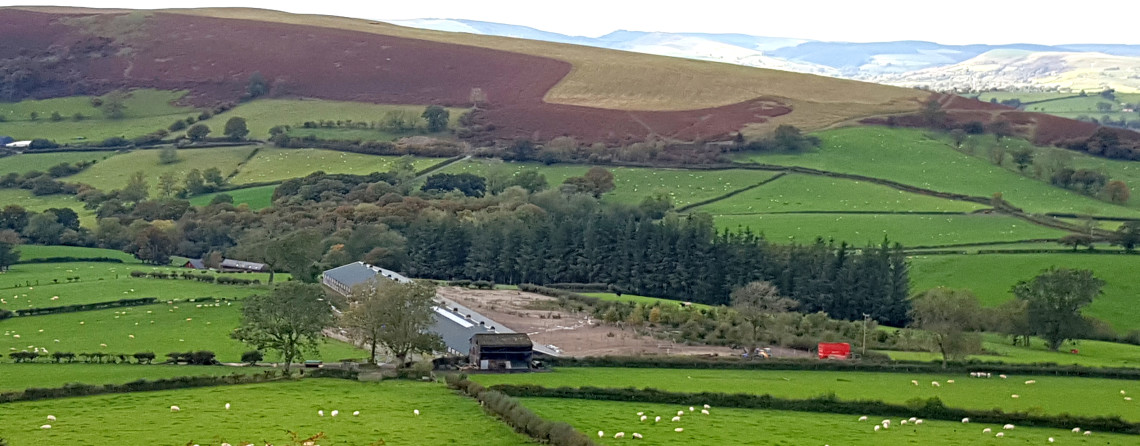 "Free range" poultry unit in the upper Wye catchment.
"Free range" poultry unit in the upper Wye catchment. Fashions in fly fishing seem to come and go. Take the Japanese Tenkara method, which was all the rage a few years back when tackle retailers were opening up special sections in their catalogues to cater for it. I think you might be hard put to buy a new Tenkara rod in the UK today. That seems a pity, because while I never felt, as some of us clearly did, that Tenkara would prove to be the method to outstrip all others, I still think it is very useful and I do enjoy using my 12 foot Seiryu rod on occasions.
The current fashion is what is rather vaguely defined as “Euro-nymphing,” which in its latest form in this country consists of a very long rod with a very sensitive tip, 2 or 3 heavy nymphs close together on the leader, usually some kind of an indicator, all used by the angler with little or no fly line beyond the rod tip and tripping the nymphs along the bottom close at hand. Don’t misunderstand me; I don’t mean to denigrate this method, which is absolutely deadly in the right hands. I use it myself at times, especially during the winter months, but it’s just that I don’t want to fish this way all the time. Incidentally, and while we are on the subject, try fishing your Euro-nymphs with a 12 or 13 foot Tenkara rod if you can lay your hands on one, using a fixed leader about the same length overall. This outfit will be lighter than your expensive and highly specialised 11ft 2 weight rod, and very effective too.
The chalk streams are a world of their own, and not always that good a training ground for free-stone rivers such as the Wye and Usk. Chalk streams themselves have certainly had their changing fashions. During the early 19th century most of the fishing was with horse hair lines and wet flies or blow flies – fishing down-wind. Such was the widely spread influence of Halford’s writing together with the advent of heavy silk casting lines that by the early years of the 20th century the chalk stream sport was now all about dry fly fishing for sighted fish. Allowing the fly to sink below the surface, even to become wet, had become some sort of crime, as was “fishing the water” or, worse still, fishing down and across in general hope of making contact.
The last two methods will still get you in trouble on many chalk stream waters. I believe the rigid ideas of Halford did the sport much damage in his day and for many years after. Then came GEM Skues who was brave enough to challenge the dry fly orthodoxy by promoting fishing a sunken nymph upstream to a fish which had been spotted, but was not in a mood to rise to the surface (which got him into a lot of trouble at the time). A few decades later it was the keeper Frank Sawyer working on the Officers’ Fishing Association water of the upper Avon who made the upstream method more efficient by devising the brilliant PTN (Pheasant Tail Nymph), weighted with fine copper wire, so that in a clear and relatively shallow river it was possible to deliver the nymph right down alongside or ahead of a fish feeding on the bottom. The development of nymph fishing on the Salisbury Avon was continued and further publicised by Oliver Kite, who came to live opposite Sawyer in the riverside village of Netheravon.
The relationships between these great names in the development of chalk stream fly fishing are interesting. Between Frederic Halford and GEM Skues, whose lives overlapped and who certainly knew each well enough, the relationship must have been slightly forced. Both of them were formidable writers, although Skues had more wit and charm. Canny solicitor as he was, Skues had enough sense not to try a frontal challenge to the great man at the height of his fame with new and clearly unwelcome ideas about “fishing wet.” Halford had, after all, proposed Skues for membership of the Fly Fishers’ Club. But after Halford’s death, Skues cautiously went into print with some suggestions about fishing the nymph below the surface in some circumstances. The row which then blew up and in 1938 resulted in a famous debate on the subject at the Fly Fishers’ Club was mainly one between the supporters of Skues and the supporters of Halford. Some people were obviously never going to be convinced, but from that point on there was a growing number of anglers prepared to experiment with the upstream nymph at times.
As a young keeper, Frank Sawyer was introduced to Skues, by then in his 90s and living in retirement by the Nadder in a hotel room full of books and papers. The older man, still reading and corresponding on his favourite subject, showed great interest in the young man’s ideas and fishing experiments and encouraged him in his early writing. It should be remembered that Frank Sawyer, as a Wiltshire countryman of his time, started out in life a little short on formal education, but became richly endowed with knowledge gained from his job and his own researches into the natural world around him.
Gaining confidence after initial reluctance, he also turned out to be a very good writer. Sawyer seems to have been a type rarely met with today, what we used to call a self-educated man. I am reminded of my own grandfather, who was just 13 when he left a village school in Norfolk, but who by the end of his life seemed to have read everything. Not having had much of it gratis, he had a huge respect for education. Sawyer, by then long established as the Officers Fishing Association keeper, published the first version of his Nymphs and the Trout describing the Netheravon style of fishing in 1958.
Major Oliver Kite with his wife and daughter arrived to live in Netheravon at White Owl Cottage as a close neighbour to the Sawyer family in the same year. Having already suffered a heart attack, his military career which had been mainly in India and the Far East was drawing to a close. He had always been mad keen on fishing and now he took every opportunity given by his rod on the OFA water which he had taken up the previous year. It seems natural enough that he would take advice from the experienced keeper on the water and his first experience with nymphing came on a difficult day when Sawyer gave him a couple of his copper wire PTNs and suggested he tried them above Choulston. There followed a “eureka moment” as he watched a trout turn aside to take the fly when he twitched it with the rod top. In Nymph Fishing in Practice, which he published in 1963, Kite gave due credit to Sawyer, describing the inventor of the Netheravon style of nymphing as a genius and the two of them as close personal friends with many shared interests apart from fishing.
Nevertheless, it seems the relationship between the two men and the two families was not always to be so easy. Sawyer, as the older man with his wealth of experience on the river and a well-earned reputation of his own, was a more introverted character. Also, Kite was or had been a commissioned officer. In an age plagued more by British notions of class than our own, and in terms of the Officers’ Fishing Association and its keeper, that made Kite one of the employers and Sawyer the employed. Was it truly a relationship between equals? For his part Kite was extrovert and genially self-confident and without doubt a highly successful communicator demonstrating an infectious enthusiasm for the British countryside.
During the next few years, quite apart from his work eventually as an angling professional, he produced a highly regarded series of natural history documentaries for the BBC. A new white Jaguar came to be parked outside White Owl Cottage. Something irked, perhaps? Maybe two great fishermen are one too many for a small village. Oliver Kite died young in 1968, much missed by his many friends around the world. An unshakeable Christian faith was a very big part of him. Still, the Sawyer family must have been particularly surprised and irritated when the paperback revised version of Nymphs and the Trout came out in 1970. The photograph on the front was one of Oliver Kite, supposedly having been found and selected by the publishers because it “looked nice.” That strikes me as a clanger similar to playing the wrong national anthem for a visiting head of state! Frank Sawyer died in 1980 on the Avon banks, while still working for what was now the Services Dry Fly Fishing Association. He had been the keeper at Netheravon for 52 years.
I am lucky enough to be invited on occasions to the Upper Avon at Heale, which is a little downstream from the Netheravon beats made famous by Sawyer and Kite. When David and I started there a few years ago, we used to fish the nymph rather more often than we do today. The reason for that change is that we found dry fly works so well on this beat - whether natural olives, sedges, mayflies or pale wateries are the cause of it - that in our experience there are few days when you must substitute a nymph to get a result. However, there are times when fish obviously feeding on nymphs are spotted on the bottom. Keeper Peter Major always encourages us to have a go at these, particularly if a big grayling is involved. Tackle changing is unnecessary, because there is a delightful simplicity about this style of nymphing; you simply use the 9 foot rod and tapered 10-12 foot leader with which you were fishing a dry fly and substitute a fly with weight. Personally I tend to use a size 14 Tungsten Hare’s Ear rather than the original copper wire PTN.
I’m sure Sawyer would have used a tungsten bead when making his nymphs if only they had been available in his day. The interesting part of the business is what it always was: persuading the weighted nymph on a fine point to duck quickly under the surface and calculating just how far upstream you need to cast it to come alongside the fish you are targeting at the right depth. In the clear waters you need a fine judgment for calculating current speed and depth. By all means give the fly a twitch when you think it is alongside the fish. Now I believe that both Sawyer and Kite were gifted with exceptional underwater eye sight. I am afraid that I am not so fortunate. I may be able to figure out where the fish is, but it is rare that I can actually watch the nymph tumbling downstream towards it. The masters used to watch for the flash of white as the fish opened its mouth as the signal to strike. Usually I cannot see that, but if the fish wavers off track even an inch to left or right I strike and it is surprising how often he turns out to have the nymph in his mouth.
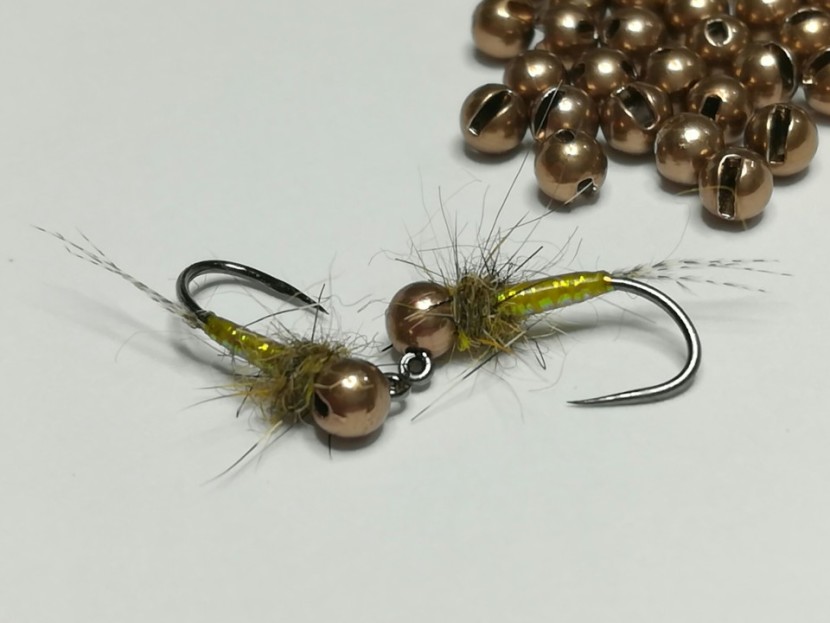 Heavy nymphs tied on jig hooks - IG from Pontypridd
Heavy nymphs tied on jig hooks - IG from Pontypridd 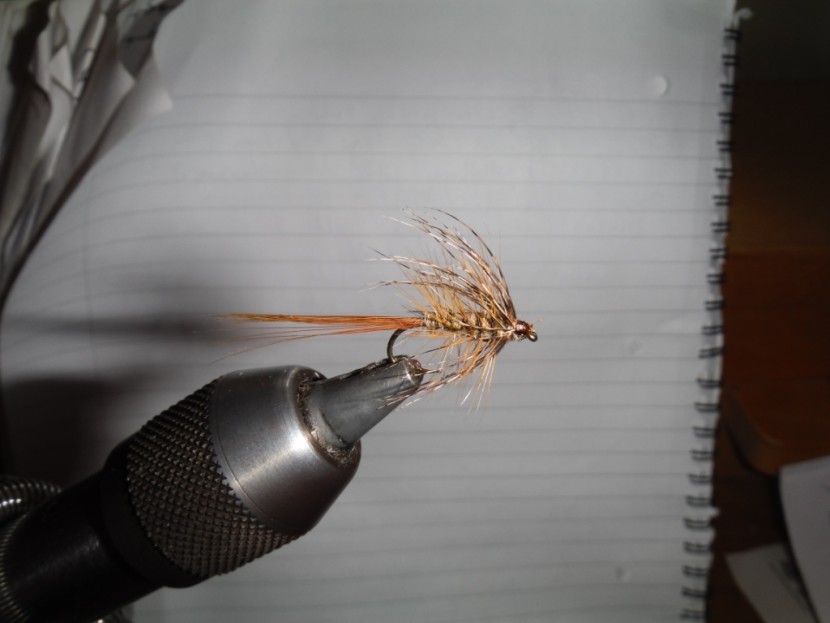 Monnow Gosling
Monnow Gosling Sawyer was interested in other forms of nymph fishing, as his book makes clear. He tried out his nymphs, quite successfully, on salmon which had come into the lower sections of chalk streams. He also fished for stocked trout on reservoirs and smaller pools, still using a single nymph and a leader with a greased butt section. In this case he observed what many of us have found out: that it pays to cast your nymph or heavy buzzer where you believe fish to be, then allow it to sink without any kind of retrieve while watching the leader point disappearing as it were down a “hole in the water” like a hawk. Rainbow trout especially love to take a nymph presented free fall in that way, and there is almost always an observable twitch or slight draw as the fish picks up the fly. Strike the moment you see any unnatural movement of the leader. This sounds very obvious, but I constantly meet anglers on still waters whose only method with a fly is to “cast it out, pull it back, and when you can’t, you’ve got one.”
To sum it all up, you might conclude that British nymph fishing in rivers for trout and grayling has gone through three phases under the masters of the day:
1. Skues: a sub-surface fly which sinks a little merely because of the light dressing without hackle or wings. It was quite common at the time to make a nymph when it was needed by snipping the wings and hackle from a dry fly, thus producing a fly with body and tail only. Fished singly upstream.
2. Sawyer and Kite: a more deliberately weighted nymph pattern with fine copper wire substituted for tying thread and forming an underbody as extra ballast. Fished singly upstream and possibly with a slight lift or “induced take” when it comes alongside a fish.
3. The East Europeans first, and now everybody else: multiple flies tied quite close on the leader, weighted first with brass and later with tungsten beads, lobbed rather than cast upstream. Much more weight than (1) or (2) and tracked along the bottom, sometimes pulled a little faster than the current. These days the Euro-nymphing style and teams of heavy nymphs are often used on chalk streams as well as rain-fed rivers for winter grayling.
Before leaving the subject, it’s worth reflecting on the commonalities across the styles. As I see it, Skues had merely taken the first step away from dry fly fishing, successful as it was. However, he knew how to see when his nymph was taken and famously wrote a light-hearted poem about that golden “wink” sub-surface. Both Sawyer and Kite made it clear in their writings that there were two options in their Netheravon method of fishing a nymph in the chalk streams. The first was to let the nymph drift quite naturally down to the fish while watching the leader or the fish itself for the take. The second, perhaps used on subsequent passes, was to give the rod a little sideways twitch as the nymph came alongside the fish in order to draw it to the trout’s attention. If the first method didn’t work, the second very likely would and this was their famous “induced take.” Rather similarly, anglers using their team of heavy Euro-nymphs today may not be able to see the fish, but may be merely watching the leader at the surface very closely as the nymphs run down naturally. Some kind of indicator or coloured section may be used on the leader to make this easier. Or some of the more successful exponents may actually be leading the nymphs downstream just a little faster than the current, thus imparting an extra semblance of life. In this case, they may actually feel the take on a sensitive rod tip. Most of the modern nymph anglers give a twitch to the nymphs at the end of the run before rolling them out of the water in a new cast upstream. Thus the induced take lives on today and a lot of fish are caught with it.
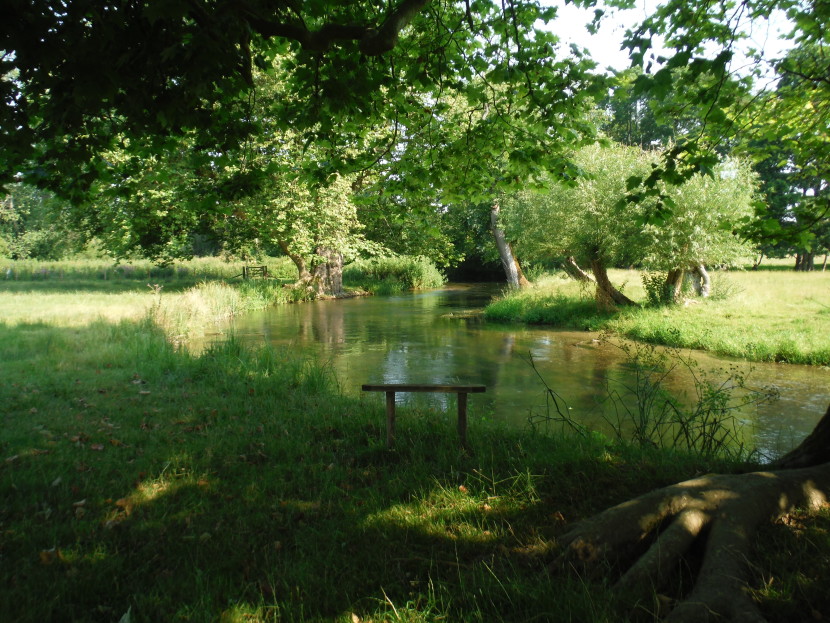 Avon meadows
Avon meadows 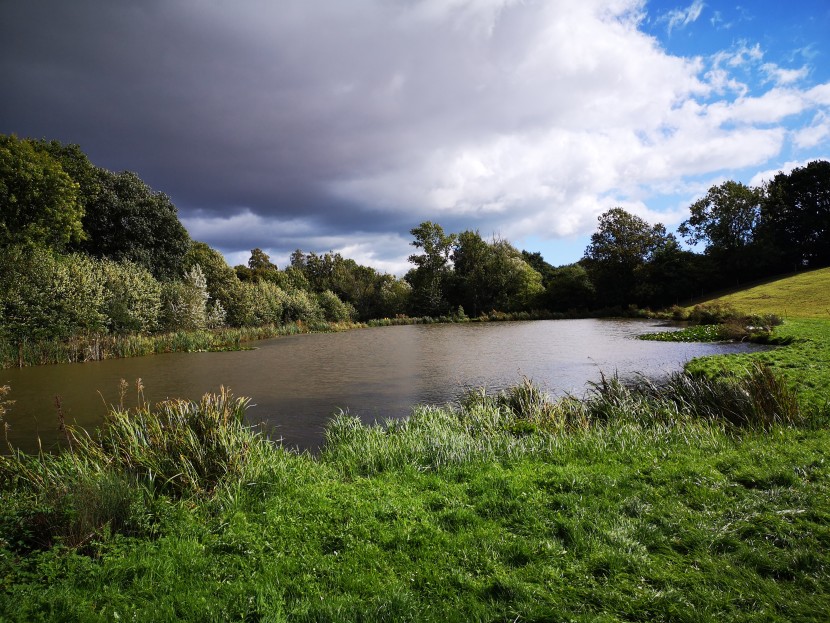 Forest pool and rain threatens
Forest pool and rain threatens 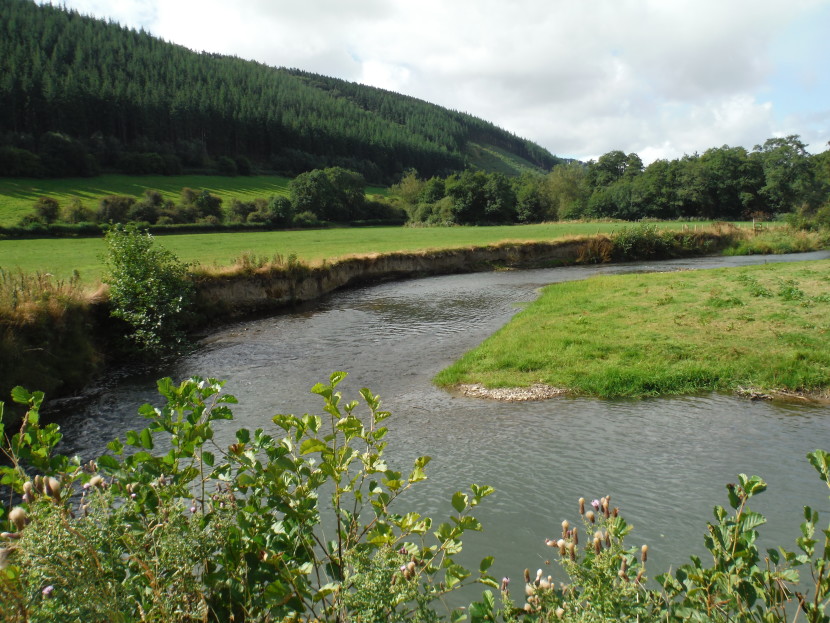 Lugg at Lyepole
Lugg at Lyepole A cabinet minister resigned last month. Did you notice? To describe the matter in its most simplistic terms, he had to resign because he kissed somebody he shouldn’t have kissed. “Ah well,” you might reflect to yourself. “What of that? There but for the grace of God…” But of course it was more complicated than that. Matt Hancock had no choice in the end because of his position advocating social distancing during the pandemic, a rising clamour of voices accusing him of hypocrisy, and perhaps the fact that he himself had recommended the resignation of a SAGE scientist who had been caught out doing something similar the previous year. On the other hand, the array of newspaper headlines I saw down at the garage on the morning of the resignation made it look like a good old-fashioned ministerial sex scandal from the last century, no more, no less. Ooh la la, Matt! Personally, I’m sorry to see the public mess, partly because of the extra pain caused unnecessarily to two families and six children, but also because I believe, apparently along with quite a lot of people inside the NHS, that Matt Hancock did a pretty good job of managing us through the pandemic.
What really makes me angry and what I really want to know more about is when was this Minister’s office last swept by the security team, how did a camera get to be there, how did the images taken by it get into the hands of the press, and did money change hands? There is a view abroad today that, short of protecting information of direct military advantage to the nation’s enemies, our elected officials and civil servants should be subjected to unlimited scrutiny at all times with no privacy at all. The sacked Dominic Cummins’ now regular revelations about private government discussions on the pandemic, who suggested what and which ideas were discussed, are a prime example. It’s normal in planning meetings that ideas are floated experimentally to be kicked around, modified or rejected. That’s how we move forward. By all means hold the meeting to account according to what was concluded, but not what was discussed. If the media are actually present, or there is a high chance of leakage to the media, ministers and civil servants are going to be pretty tight-lipped for reasons of self-defence and the discussion is unlikely be productive of anything useful.
To cheer up you salmon fishers with a tale from the glory days, this gem was recently culled from BB’s The Fisherman’s Bedside Book, published in 1945:
“A Forty Pounder from the Wye: When fishing on the Wye some years ago I noticed a very large salmon in a deep pool. For two days a friend and I had tried to catch this fish with various lures but had met with no success. Picking up a large piece of rock I hurled it in, with the object of frightening him up into the pool above.
When I went down early next morning I was into a very large salmon at my third cast, which rushed down-river, taking out all my line to the backing and then finally stopping in the very pool into which I had thrown the stone the day before. I was able to wade down to him, but with some difficulty as I was in the middle of the river and a strong current was running. Of course I was winding in all the time.
The fish never moved until I got level with him and then I had twenty-five minutes fight before I got him in. When my gillie gaffed him he was knocked flat into the water by the fish’s tail and I had to seize the gaff and bring the fish in myself!
He weighed forty pounds and I am sure it was the same fish I had bombarded with the rock the day before.
Miss VM Pilcher.”
Ah, those were the days! I am not quite sure if anything more is known about Miss VM Pilcher, but she must have been one of those heroic women who caught all the big fish in those times. What a spiffing girl! I can picture her sweeping the unfortunate gillie aside as she strode once more into the river to drag out her giant salmon.
Miss Pilcher, Miss Pilcher! I’m sure that laureate Sir John Betjeman, who was well known for having a thing about athletic ladies, would have made a first class poem about her if he had not come across Miss Joan Hunter Dunn playing tennis first. Incidentally, I’m pretty certain it is illegal now to heave rocks at salmon in pools, although today you can just bet that sooner or later somebody will land from a canoe and do the job for you.
Oliver Burch